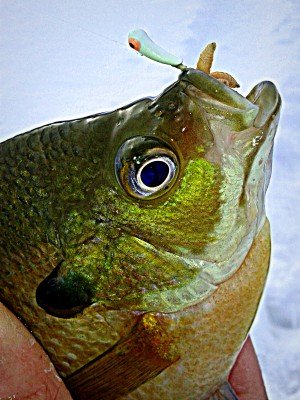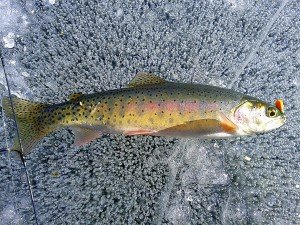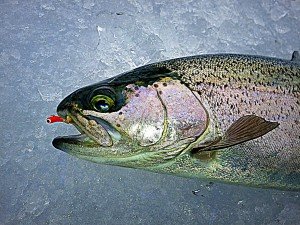
J.R.’s Tackle Jalapeno
This isn’t necessarily a brand new topic but I’m still amazed at the amount of people I speak to on the ice, forums, or in the bait stores that don’t use or know much about Tungsten jigs.
This will be my 4th year using Tungsten through the ice. I’ll never forget the first time I used a tungsten ice jig instead of my go-to lead jigs. I was fishing a Crappie hole with a friend on a Minnesota lake. We were sitting in 38 feet of water and the school was hanging out near the lake bottom. When I dropped my lead jig down it would take a long time for it to reach the school. After a short while, I realized that my buddy was catching fish more frequently than I was. I then noticed that his jig, although the same size and profile, was reaching the school much quicker than mine. I asked him what he was using and he said “I bought these new Tungsten jigs and I really like them”. I recognized Tungsten as a metal from my past Chemistry classes but didn’t know much about it. He had me tie one on and I was sold.
After that I went home and did some research, it turns out Tungsten is a chemical element which is more than 1.5 times heavier than lead. I began to realize the incredible advantages tungsten provides over the lead jig counterpart.
Tungsten’s heavier weight allows for a smaller profile jig, which is a huge advantage when the fish are finicky. The added weight also allows the jig to fall much quicker, so you can get back down to the fish or school of fish once you find them. In addition, a tungsten jig will be more visible on your flasher due to the heavier density of the material.
Another advantage is that the jigs will fall easier through the slush at the top of the hole, this is great for hole-hopping, so you don’t have to take as much time clearing the slush from each hole. Tungsten jigs also have the ability to penetrate weed cover that can typically be home to several different species of fish. The increased weight will also keep your fishing lines tighter, allowing a better feel with your ice fishing rod.
Unfortunately, tungsten jigs are more expensive than their lead counterparts, sometimes running up to three dollars per jig. These jigs, at one point, were difficult to find at local retailers but now with more and more major companies beginning to manufacture Tungsten jigs (Northland Tackle in 2012, Clam, Lindy, and Custom Jigs & Spins in 2013) they are becoming more accessible. If you’re local retailer still doesn’t carry any Tungsten options, there are many online stores/sites which sell them. Here are some of my favorite Tungsten jigs: J.R.’s Tackle “Jalapeno”, Skandia “Pelkie” jig, and Fiskas “Wolfram” jig.
According to many outdoor experts, tungsten is environmentally friendly. Lead has been banned by some states due to the potential harm to wildlife, especially water fowl, if ingested. And more states are soon expected to follow this directive.
Consider tungsten as an alternative to your ice fishing jig assortment. The advantages are numerous, and the wildlife will thank you. The biggest advantage is that these heavy jigs are great fish catchers. In fact, I don’t think it’s a coincidence that my catch rate has dramatically increased since I started using Tungsten jigs!

